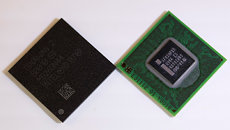Wednesday, May 5th 2010

New Intel Atom Processor Platform Significantly Lowers Power for Tablet and Handheld
Benefitting from the company's power-saving architecture, transistor and circuit design expertise, plus unique manufacturing process techniques, Intel Corporation today unveiled its newest Intel Atom processor-based platform (formerly "Moorestown").
The technology package provides significantly lower power consumption and prepares the company to target a range of computing devices, including high-end smartphones, tablets and other mobile handheld products. The chips bring Intel's classic product strengths - outstanding performance to run a comprehensive and growing number of rich media and Internet applications, a choice of software, and the ability to easily multitask - across a number of applications, including HD video and multi-point videoconferencing."Intel has delivered its first product that is opening the door for Intel Architecture [IA] in the smartphone market segment," said Anand Chandrasekher, Intel senior vice president and general manager of the Ultra Mobility Group. "Through "Moorestown," Intel is scaling the benefits of IA while significantly reducing the power, cost and footprint to better address handheld market segments. As a result of our efforts, the Intel Atom processor is pushing the boundaries of higher performance at significantly lower power to show what's possible as handheld devices become small, powerful mobile computers."
Architected for Low Power and Industry Leading Performance
The platform includes the Intel Atom Processor Z6xx Series Family (formerly "Lincroft" system-on-chip [SoC]), the Intel Platform Controller Hub MP20 (formerly "Langwell") and a dedicated Mixed Signal IC (MSIC), formerly "Briertown."
The platform has been repartitioned to include the Intel Atom Processor Z6xx, which combines the 45nm Intel Atom processor core with 3-D graphics, video encode and decode, as well as memory and display controllers into a single SoC design. It also includes the MP20 Platform Controller Hub which supports a range of system-level functions and I/O blocks. Additionally, a dedicated MSIC integrates power delivery and battery charging, and consolidates a range of analog and digital components.
Collectively these new chips deliver significantly lower power including >50x reduction in idle power, >20x reduction in audio power, and 2-3x reductions across browsing and video scenarios - all at the platform level when compared to Intel's previous-generation product1. These power savings translate into >10 days of standby, up to 2 days of audio playback and 4-5 hours of browsing and video battery life3. When combined with 1.5-3x higher compute performance, 2-4x richer graphics, >4x higher JavaScript performance, and support for full HD 1080p high-profile video decoding and 720p HD video recording, these low-power innovations bring a rich, PC-like visual experience to powerful handheld computers.
Building on the C6 state in the original Intel Atom processor design, the SoC incorporates new ultra-low-power states (S0i1 and S0i3), which take the SoC to 100 micro-watts. At the platform level, Intel implemented a new, fine grain OS power management approach that manages the idle and active power states across all aspects of the system based on usage scenarios. This software-managed technique applies aggressive power and clock gating across the SoC's power islands and system voltage rails. Additionally, Intel used a new high-K 45 nm LP SOI process to support a multiple transistor design with a range of high-voltage I/Os.
These power management capabilities, when combined with Intel Burst Performance Technology for high-performance on demand, and Intel's Bus Turbo Mode for high-bandwidth on demand, help to deliver industry leading performance and power efficiency across a range of handheld devices.
"After we delivered the first-generation Intel Atom processor with 10x thermal power reduction, we challenged ourselves to achieve 50x power reduction at the platform level," said Belli Kuttanna, chief Intel Atom processor architect. "We are delighted to have exceeded this goal while increasing performance and are proud of the architects and designers who consistently reinvent the possibilities of Intel Architecture."
Availability
The Intel Atom Processor Z6xx Series Family, Intel Platform Controller Hub MP20 and the dedicated Mixed Signal IC are available today.
The new platform supports a range of scalable frequencies, up to 1.5 GHz for high-end smartphones and up to 1.9 GHz for tablets and other handheld designs. The chips also bring support for Wi-Fi, 3G/HSPA, and WiMAX, as well as a range of operation systems, including Android, Meego and Moblin. Intel is bringing together a breadth of applications and ecosystem support across these platforms to enable a software- and Internet-compatible user experience for developers and consumers.
HIGHLIGHTS
The technology package provides significantly lower power consumption and prepares the company to target a range of computing devices, including high-end smartphones, tablets and other mobile handheld products. The chips bring Intel's classic product strengths - outstanding performance to run a comprehensive and growing number of rich media and Internet applications, a choice of software, and the ability to easily multitask - across a number of applications, including HD video and multi-point videoconferencing."Intel has delivered its first product that is opening the door for Intel Architecture [IA] in the smartphone market segment," said Anand Chandrasekher, Intel senior vice president and general manager of the Ultra Mobility Group. "Through "Moorestown," Intel is scaling the benefits of IA while significantly reducing the power, cost and footprint to better address handheld market segments. As a result of our efforts, the Intel Atom processor is pushing the boundaries of higher performance at significantly lower power to show what's possible as handheld devices become small, powerful mobile computers."
Architected for Low Power and Industry Leading Performance
The platform includes the Intel Atom Processor Z6xx Series Family (formerly "Lincroft" system-on-chip [SoC]), the Intel Platform Controller Hub MP20 (formerly "Langwell") and a dedicated Mixed Signal IC (MSIC), formerly "Briertown."
The platform has been repartitioned to include the Intel Atom Processor Z6xx, which combines the 45nm Intel Atom processor core with 3-D graphics, video encode and decode, as well as memory and display controllers into a single SoC design. It also includes the MP20 Platform Controller Hub which supports a range of system-level functions and I/O blocks. Additionally, a dedicated MSIC integrates power delivery and battery charging, and consolidates a range of analog and digital components.
Collectively these new chips deliver significantly lower power including >50x reduction in idle power, >20x reduction in audio power, and 2-3x reductions across browsing and video scenarios - all at the platform level when compared to Intel's previous-generation product1. These power savings translate into >10 days of standby, up to 2 days of audio playback and 4-5 hours of browsing and video battery life3. When combined with 1.5-3x higher compute performance, 2-4x richer graphics, >4x higher JavaScript performance, and support for full HD 1080p high-profile video decoding and 720p HD video recording, these low-power innovations bring a rich, PC-like visual experience to powerful handheld computers.
Building on the C6 state in the original Intel Atom processor design, the SoC incorporates new ultra-low-power states (S0i1 and S0i3), which take the SoC to 100 micro-watts. At the platform level, Intel implemented a new, fine grain OS power management approach that manages the idle and active power states across all aspects of the system based on usage scenarios. This software-managed technique applies aggressive power and clock gating across the SoC's power islands and system voltage rails. Additionally, Intel used a new high-K 45 nm LP SOI process to support a multiple transistor design with a range of high-voltage I/Os.
These power management capabilities, when combined with Intel Burst Performance Technology for high-performance on demand, and Intel's Bus Turbo Mode for high-bandwidth on demand, help to deliver industry leading performance and power efficiency across a range of handheld devices.
"After we delivered the first-generation Intel Atom processor with 10x thermal power reduction, we challenged ourselves to achieve 50x power reduction at the platform level," said Belli Kuttanna, chief Intel Atom processor architect. "We are delighted to have exceeded this goal while increasing performance and are proud of the architects and designers who consistently reinvent the possibilities of Intel Architecture."
Availability
The Intel Atom Processor Z6xx Series Family, Intel Platform Controller Hub MP20 and the dedicated Mixed Signal IC are available today.
The new platform supports a range of scalable frequencies, up to 1.5 GHz for high-end smartphones and up to 1.9 GHz for tablets and other handheld designs. The chips also bring support for Wi-Fi, 3G/HSPA, and WiMAX, as well as a range of operation systems, including Android, Meego and Moblin. Intel is bringing together a breadth of applications and ecosystem support across these platforms to enable a software- and Internet-compatible user experience for developers and consumers.
HIGHLIGHTS
- Based on Intel's leading silicon technology and manufacturing capabilities, chips deliver >50x platform idle power reduction while increasing performance and reducing size1.
- Platform brings unlimited "PC-like" experience with fast Internet, multi-tasking, full 1080p video, 3-D graphics, multi-point videoconferencing and voice in pocketable designs.
- New Intel Atom Processor Z6xx based on Intel's new 45nm low-power process, packs 140 million transistors into the SoC. The platform also includes a Controller Hub (MP20) and a dedicated Mixed Signal IC.
- Highly integrated platform capable of scaling a range of operating systems and market segments including high-end smartphones, tablets and handheld devices.



37 Comments on New Intel Atom Processor Platform Significantly Lowers Power for Tablet and Handheld
2) Linux is installed in less than 2% of the world's computers, mostly web-servers, which again use x86 processors such as Intel Xeon and AMD OpteronLoads of instruction sets are what speed up the processor, add to its IPC efficiency. Almost every application you use make use of them.Wrong. x86 processors are proportionately powerful to their wattage, compared to ARM.What's keeping Linux alive is mostly x86.Android is a Linux distribution. It supports x86, so once Intel gets into handheld processors, Android will seamlessly run it, so no, Android has no impact.x86 just entered that segment.A vast majority of tablets and notebooks use x86 processors.Linux will never beat Windows in desktops. People have been dreaming about that since 1995.What do you like?
I cant say for sure whats the best right thing, something someone doesnt controll so badly that there is no compotition, ARM is deffy over X86 just cause the fact that it allows more compotition.
I don't know about ARM and HPC so cant really tell if i like it or not, all i can say a snapdragon is snap in a phone.
Linux(more like Unix) got more units built on non x86 than x86 FYI
Dead tech subject, gotta go to meeting, its in interviews with both AMD and Intel about these functions, and limitations.
And ofc strengths of x86.
Main reason why i dont like x86 is already said. ( license )
x86 is as "open source" as Linux, AMD, Intel etc all have their own flavours of it, much like different flavours as Linux. For example, AMD has SSE5 on Bulldozer while Intel has SSE4 on the core ix processors. You need as much license to run Linux as making x86 compliant processor.
Also, I don't buy all those "competition" bullsiht: If all processors are only ARM compliant, then everyone will have as much functionality as an iPad (read: none). I'll pass on that.
2nd
A licence to run linux?
No, you just are implied to pass the knowledge on, it has a licence, THE GPL GNU and the other flavors of it.
X86 is controlled by a firm, If i want to start up a X86 chip designer, I HAVE to get a licence that i pay for to Intel, worth loads of cash.
And then, if i have loads of cash, IE. being google, if they want to make chips, maybe intel dont want to, then denied, i cant, intel can deny companies as they want, they tried to deny global foundries of producing x86 chips, marketing or not, tells the story.
Linux, download, run, sell (yes i can) but any changes to the kernel and other GPL/GNU projects have to be passed on(provide the source code)
So the two compared licence things are rather incomparable.
Other architectures: Sparc(proven HPC capable)(mostly dead) open and royalty free. PowerPC(also HPC capable), and X86, Closed and requires royalty, so not as open as linux as you states, rather 100% the opposite.
The only reason x86 is still around is that it got the popular vote a long time ago, and now that Microsoft dominates the operating system space, there is not choice but to continue down that route.
The instruction sets found in modern ARM processors are far more efficient in most areas that are important to mobile technology, than their archaic x86 based brethren
Here is a list of architectures that I grabbed of Wikipedia:
* 4004, 4040
* 6800, 6502, 6809, 68HC11, 68HC08, etc
* 8008, 8080, 8085, Z80, Z180, eZ80, etc
* 8048, 8051, etc
* Z8, eZ8, etc
* Burroughs B5000/B6000/B7000 series
* eSi-RISC
* Mico32
* PA-RISC
* IBM 700/7000 series
* System/360 and upwards compatible successors
o System/370
o System/390
o z/Architecture
* PDP-11
o VAX
* SPARC
* SuperH
* Tricore
* Transputer
* UNIVAC 1100/2200 series
* EISC (AE32K)
All of those a really rare.
* Motorola 68k
* Alpha
Nobody uses these anymore
* ARM
ARM, while it is energy efficient is very slow.
* IA-64 (Itanium)
Itanium is in servers and workstations etc only and is pretty rubbish.
* MIPS
I think the only really new MIPS chip is in the PSP and PS2.
* Power Architecture
o POWER
o PowerPC
POWER/PowerPC used to be used in Macs but now it is only in the consoles and super computers, and I know all those chips are inefficient. Fast, but inefficient.
* x86
o IA-32 (i386, Pentium, Athlon)
o x86-64 (64-bit superset of IA-32)
And we come to x86 which while it may be old, it still works great. If you were to get an ARM chip to do the same level of performance as a Core i7, I'd say it would be way hotter and consume way more power. ARM is actually pretty slow and the only reason it is keeping up in the mobile market is because it is so open and people can just slap in more stuff like H.264 and such. I'm not saying ARM is slow, because it is pretty impressive what it can do, but I really don't think it would be as powerful as x86.
You were asked what architecture you like, and the list is there. Which one is the best out of them, and I can tell you now my preference is definately x86 because there market is so competitive, AMD, VIA and Intel have to work so hard to make it better. ARM is so quiet, it almost stands still.
Dell, ARM and marvel will make server cpu's...
Just read it from IBM.
And Marvel will deliver 1.2-2 Ghz cpu's for (no) HPC yet but for WHS and NAS.
Marvel already provide NAS chips based on ARM, which is indeed a server.
Albeit the HPC market stays with gpu power, X86 and PowerPC, and some still run Sparc. some of the top 500 is still sparc yeah!
what did i say ?:)5 Years worth of licence:
1 Billion usd. Opensource my A.
Intel profits from it, they choose
A.\ who can design chips.
B.\ They prevent other archs from entering the market by blocking, just like microsoft.